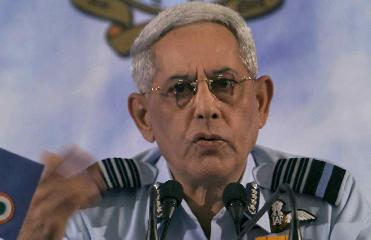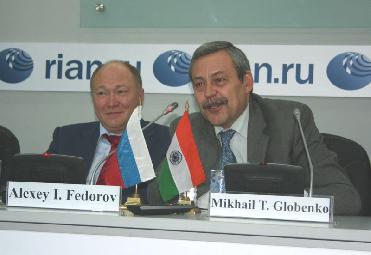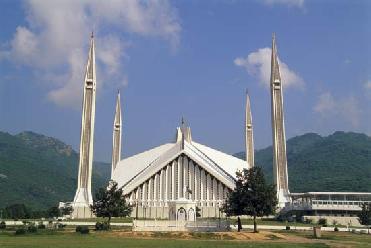
Air Chief Marshal FH Major addressing media in New Delhi on Friday
NEW DELHI (BNS): The Indian Air Force is on the verge of massive transformation in seven to ten years. The change is both in terms of its character and concepts. From essentially being a MiG flying air force, the coming years would see a new IAF operating a modern diverse fleet in hi-tech environment.
The changing face was enlisted by IAF chief, Air Chief Marshal Fali Homi Major, in New Delhi, ahead of IAF's 76th birthday on October 8. The top officer felt his force was passing through a ‘peculiar phase’. “At the pace at which we are going we will see a very different air force in seven to ten years,” he said.
For some time now IAF has been battling hard to keep minimum force levels. Most of its equipment, aircraft bought mostly from erstwhile Soviet Union, is ageing. It was a tricky decision for IAF whether to phase them out or drag them on until their utility was exploited to the maximum.
But most of the aircraft cannot be stretched beyond a limit. Realising the fact the IAF has gone out on a buying spree in the international market. With the government backing it financially, the IAF has drawn an impressive plan to augment its fleet and increase its war fighting capabilities.
In the process, new systems and concepts are being introduced in the force. The IAF, for the first time, would start operating with an airborne early warning command and control system, Phalcon. Bought from Israel and installed on Russian IL-76 transport aircraft, three Phalcon systems are expected starting January next year.
The IAF also has plans to add six more mid-air refuellers. Currently, it operates six IL-78 air-to-air refuellers. It wants six more and the choice is between IL-78 or A330 tankers. The air-to-air refueling capabilities are being seen as a key to IAF's trans border operations.
It has given a new reach to IAF jets. All the leading air forces in the world had the capability but the IAF has now caught up with them.
The other major changes in the offing are in the fighter jet area. The IAF expects to build a force of 230 top of the line Su-30 MKI by 2014. The aircraft are being licence produced by the government-run Hindustan Aeronautics Limited. HAL's production facility builds 18 to 19 aircraft for IAF every year. “The HAL produced 15 of them this year, we want it to go up to 22 to 23 a year,” Major said.
The IAF is presently scrutinizing the technical bids submitted by global aviation giants for the proposed 126 medium multi-role combat aircraft (MMRCA). Top aviation companies of the world, the best in the business, are competing for the Indian contract pegged to be worth over 10 billions dollars by today’s valuation. The new fighter aircraft would be operated along with an upgraded fleet of existing fighters like MiG-29s and Mirage 2000s.
The IAF’s aim is to “build up capabilities to address all spectrums of warfare,” Major said. Looking beyond the present crop of fighter jets, India has already planned to co-produce a fifth generation combat aircraft with Russia.
The biggest change perhaps would be on the transport fleet of IAF. It has already ordered six C-130 Super Hercules from the US. The plane would be used primarily for special forces’ operations.
The IAF will change its entire fleet of IL-76 aircraft of Russian origin in immediate future, Major said. It would soon hit the market seeking bids to replace the IL-76s, but the replacements would be “very heavy transporters”, he said. The ageing fleet of An-32 aircraft will undergo upgradation meanwhile, and the new An-32 would have glass cockpits, GPS and other modern avionics, he said.
The helicopter scene is also warming up. The IAF has ordered 80 new Mi-17 medium lift helicopters from Russia. It is looking to buy 125-plus light utility helicopters from the international market. More of the locally produced Advanced Light Helicopters are also being added to the fleet, and at least 16 of them would be armed, he said. The IAF has completed the evaluation of the possible VVIP helicopter to fly country's top leaders. Eight of them would be dedicated to VVIP duties, while another four will be cargo versions.
Apart from the flying assets, IAF is looking to include an entire range of new precision-guided weapons. There would be new air-to-ground and air-to-air missiles fitted on its aircraft. It has already ordered low-level quick reaction Spyder missile from Israel.
Ground support would be strengthened in terms of new radars. The IAF wants to have several new Israeli Aerostat radars apart from indigenously produced Rohini radar. The IAF had recently inducted a batch of Rohini radars and is satisfied with its performance.
"We are going to be a very different air force in the next seven to 10 years," said Air Chief Marshal Fali Major.
“Peninsular India is a huge area. Yes, we do have gaps (in air defence). But we are in the process of filling up these gaps. We are acquiring all types of radars -- high-level, low-level, high-power, and low power and others,” he said.
 Previous Article
Previous Article Next Article
Next Article













The Indian Air Force, in its flight trials evaluation report submitted before the Defence Ministry l..
view articleAn insight into the Medium Multi-Role Combat Aircraft competition...
view articleSky enthusiasts can now spot the International Space Station (ISS) commanded by Indian-American astr..
view article